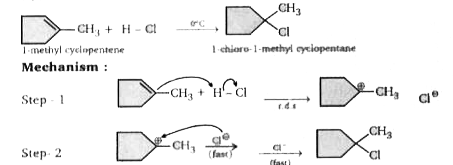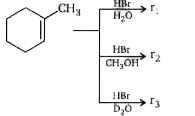Complete Solutions to LEVEL-2 of chapter HYDROCARBONS (ALKENES) of Class 12 book with complete answers and questions
| Class 12 | CHEMISTRY |
| Chapter | HYDROCARBONS (ALKENES) |
| MS CHOUHAN | LEVEL-2 |
| Number Of Questions | 22 |
| Academic Year | 2023-24 |

In each reagent box write a letter designating the best reagent and condition selected from the above list of reagents.

View SolutionPropene `(CH_3 – CH = CH_2) `can be transformed to compounds (a to j) listed in the left-hand column. Write letter designating the reagent, you believe will achieve desired transformation. In the case of a multi step sequence write the reagent in the order they are to be used.


View SolutionIn each reaction box write a single letter designating the best reagent and condition selected from the list at bottom of the page. (F.S., `to ` first step, S.S `to` second step, T.S. `to` third step)

View SolutionMatch the reagents a-j with products A-J. There is one best product for each reaction.

The molecule (x) is the starting material for all reactions in problem. Do the ones you know first and then tackle the rest by deductive reasoning

View SolutionMatch the column :

View SolutionMatch the column I with column II and with column III (Matrix).

View SolutionMatch the column I and II.

View SolutionSum of molecular mass of A, B, C, D (i.e. A+B + C + D) is equal to :

View Solution`underset("(all isomers) ")(C_2FClBrl) underset(Ni) overset(H_2)to (A)`(exclude stereoisomer)
(2) `underset("(all isomers)")(C_4 H_8 "(alkene)")underset(Ni) overset(H_2) to (B) ` (exclude stereoisomer) A+B=
View SolutionMatch the following columns

View SolutionVladimir Markovnikov rule : Alkenes undergo electrophilic addition reactions. It is triggered by the acid acting as a electrophile toward t-electrons of the double bond. Markovnikov's rule states that when an unsymmetrically substituted alkene reacts with a hydrogen halide, the hydrogen atom adds to the carbon that has the greater number of hydrogen, e.g.,

Which of the following is most reactive toward Markovnikov addition ?
View SolutionVladimir Markovnikov rule : Alkenes undergo electrophilic addition reactions. It is triggered by the acid acting as a electrophile toward t-electrons of the double bond. Markovnikov's rule states that when an unsymmetrically substituted alkene reacts with a hydrogen halide, the hydrogen atom adds to the carbon that has the greater number of hydrogen, e.g.,

What is the energy profile for the given reaction ?
View SolutionVladimir Markovnikov rule : Alkenes undergo electrophilic addition reactions. It is triggered by the acid acting as a electrophile toward t-electrons of the double bond. Markovnikov's rule states that when an unsymmetrically substituted alkene reacts with a hydrogen halide, the hydrogen atom adds to the carbon that has the greater number of hydrogen, e.g.,

In which of following reactions carbocation rearrangement is possible ?
View SolutionVladimir Markovnikov rule : Alkenes undergo electrophilic addition reactions. It is triggered by the acid acting as a electrophile toward t-electrons of the double bond. Markovnikov's rule states that when an unsymmetrically substituted alkene reacts with a hydrogen halide, the hydrogen atom adds to the carbon that has the greater number of hydrogen, e.g.,

Identify the major products `r_1, r_2, and r_3` in the given reactions.

View SolutionVladimir Markovnikov rule : Alkenes undergo electrophilic addition reactions. It is triggered by the acid acting as a electrophile toward t-electrons of the double bond. Markovnikov's rule states that when an unsymmetrically substituted alkene reacts with a hydrogen halide, the hydrogen atom adds to the carbon that has the greater number of hydrogen, e.g.,

In which of the following reactions, product is racemic mixture ?
View SolutionVladimir Markovnikov rule : Alkenes undergo electrophilic addition reactions. It is triggered by the acid acting as a electrophile toward t-electrons of the double bond. Markovnikov's rule states that when an unsymmetrically substituted alkene reacts with a hydrogen halide, the hydrogen atom adds to the carbon that has the greater number of hydrogen, e.g.,

In which of the following reactions, diastereomers will be formed ?
View Solution`CH_3 - CH_2-CH=CH_2+CH_2 OH overset(H^(o+))to CH_3-CH_2- underset(OCH_3) underset(|)(CH)-CH_3`
What is electrophile in first step?
View Solution`CH_3 - CH_2-CH=CH_2+CH_2 OH overset(H^(o+))to CH_3-CH_2- underset(OCH_3) underset(|)(CH)-CH_3`
What is nucleophile in first step?
View Solution`CH_3 - CH_2-CH=CH_2+CH_2 OH overset(H^(o+))to CH_3-CH_2- underset(OCH_3) underset(|)(CH)-CH_3`
What is electrophile in second step ?
View Solution`CH_3 - CH_2-CH=CH_2+CH_2 OH overset(H^(o+))to CH_3-CH_2- underset(OCH_3) underset(|)(CH)-CH_3`
What is nucleophile in second step ?
View Solution`CH_3 - CH_2-CH=CH_2+CH_2 OH overset(H^(o+))to CH_3-CH_2- underset(OCH_3) underset(|)(CH)-CH_3`
Which step is rate determining step ?
View SolutionMatch the column I and II :

View Solution
LEVEL-2 questions and complete solutions for chapter HYDROCARBONS (ALKENES) of MS CHOUHAN of Class 12